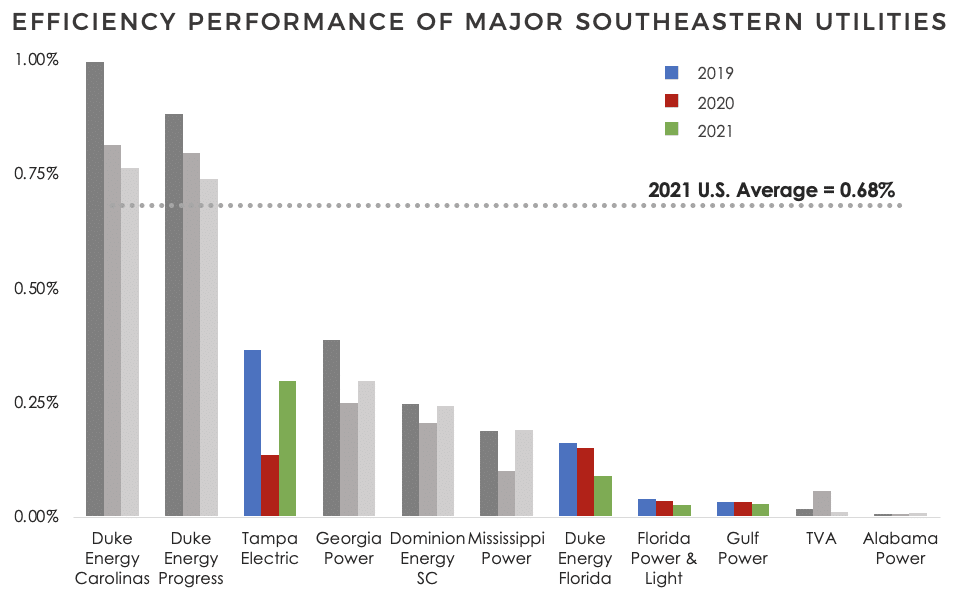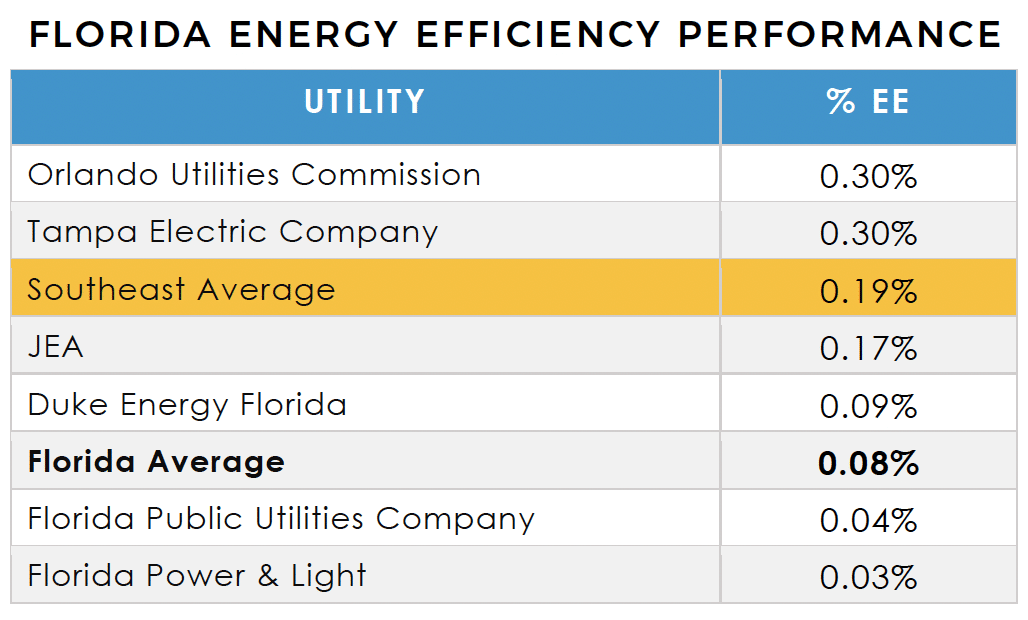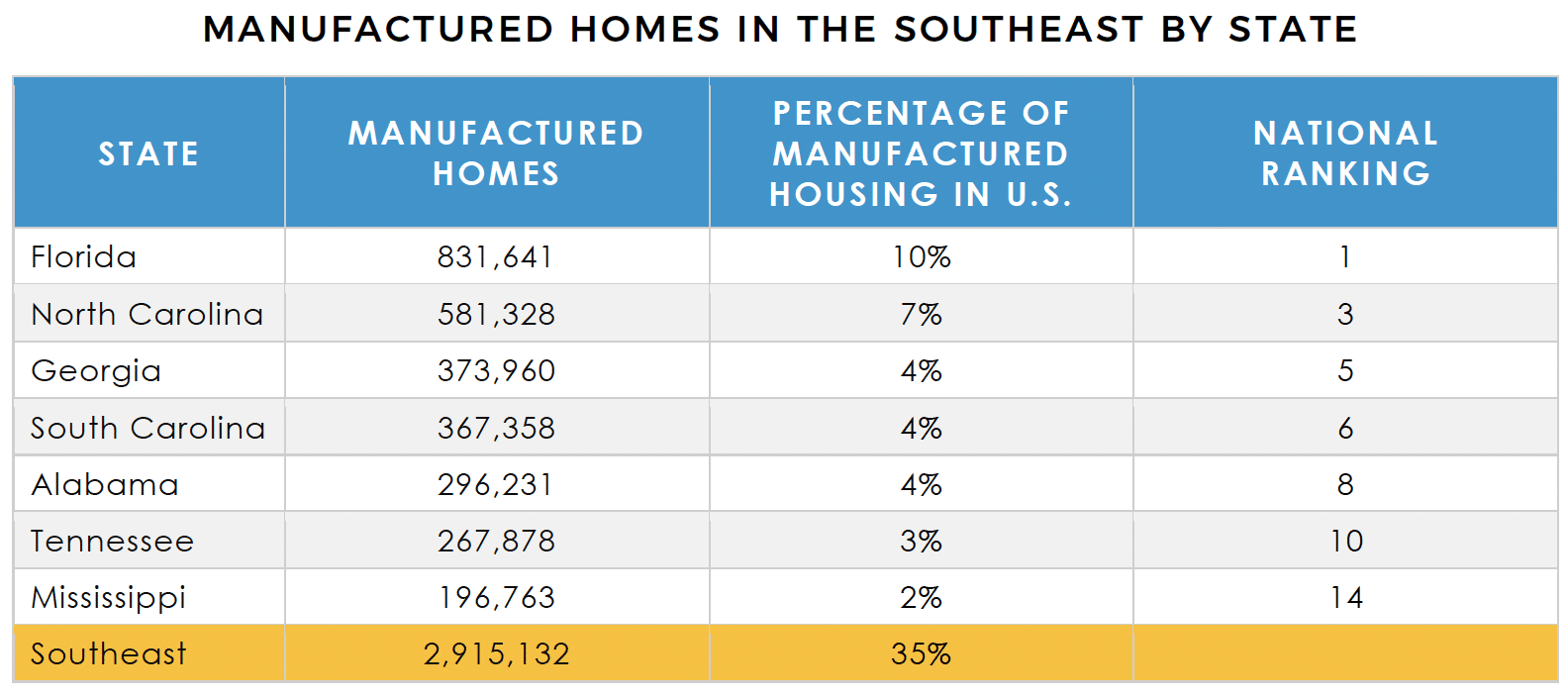Each year the Southern Alliance for Clean Energy compiles efficiency performance data from nearly 500 electric utilities in the Southeast, comparing them based on annual efficiency savings as a percentage of total utility electric sales. The data and analysis for 2021 are presented here in our fifth annual “Energy Efficiency in the Southeast” report. This blog post, the second in our series, examines Florida’s unique energy efficiency policies, practices, and performance issues. In the coming weeks, SACE will publish additional blog posts on other energy efficiency topics of interest from across the Southeast.

Watch the Webinar Read the Report Read the Report Blog Series
Florida’s historically low energy efficiency performance is directly tied to the policies and practices used by the state’s regulators – Florida Public Service Commission – when setting utility efficiency savings goals every five years. In 2019, many of the major utilities in Florida exploited weaknesses in the state’s energy efficiency rules to propose efficiency savings goals of zero, or near zero. This in turn prompted the Commission to reject the utilities’ filings and open a review of the state’s badly outdated efficiency rules, which have been unchanged since the early 1990s.
This blog post explores the impacts that existing policies have had on Florida’s efficiency performance and identifies three of the most impactful changes the Commission will soon consider. We also highlight the need and opportunity to prioritize efficiency for manufactured housing in Florida.
Florida Utilities Achieve Only a Fraction of National Efficiency Savings Levels
Florida utilities have consistently delivered annual efficiency savings that are far below the national average. To put this in perspective, the national average for annual efficiency savings in 2021 was more than 20 times higher than what Florida Power & Light delivered to its customers. Florida’s largest utilities also trail their peers in the Southeast, which itself is the worst-performing region in the country.

In the nearly three years since the Florida Public Service Commission announced its energy efficiency rulemaking, Florida customers have experienced painful increases in electricity bills, owing to the state’s over-reliance on volatile fossil gas for approximately 70% of its power generation. Hard-working families are now paying more than ever for electricity. Cutting energy waste is a natural solution, but unfortunately, customers in Florida have few options to access the kind of utility energy efficiency programs that could help them cut their monthly power bills.
Big picture, investing in energy efficiency is far less expensive than building new power plants, therefore expanding energy efficiency is also the most cost-effective solution for reducing our dependence on fossil gas while lowering total utility costs for all customers.
Florida Commission to Consider Modernization of Its Efficiency Rules
With the state’s energy efficiency rulemaking process nearly complete, the Florida Public Service Commission will soon decide whether to change the most outdated aspects of its current energy efficiency practices. Today, the Southern Alliance for Clean Energy and other non-utility stakeholders each filed formal requests for a full Commission hearing to consider modernizing its efficiency rules to increase future efficiency savings in Florida.
SACE and a broad coalition of local governments, businesses, and non-profit groups, along with thousands of citizens have submitted comments urging the Commission to make substantive changes to the state’s efficiency rules. A consistent theme throughout our coalition’s comments has been asking the Commission to address three particularly problematic issues in the state’s outdated rules with the following solutions:
Three Solutions to Fix Florida’s Broken Efficiency Rules
- Count the financial savings from energy efficiency as a benefit in the cost-effectiveness analysis used to set utility efficiency goals. Common sense, right? Unfortunately, Florida is the only state in the country that treats lower energy bills from cutting energy waste (which is the central purpose of efficiency) as a cost (due to lower utility revenues), rather than as a benefit when setting utility efficiency savings goals. Simply adding the Utility Cost Test to the rules would ensure the Commission considers whether increasing efficiency would be less expensive for all customers than more spending on power generation. Simply put, the Utility Cost Test compares whether cutting energy waste is less expensive for all customers than generating more power supply.
- Require utilities to adopt industry-standard methods for counting only the savings that directly result from utility efficiency programs (also known as addressing free ridership). Florida is the only state in the country to automatically eliminate efficiency measures that pay back within two years (as a proxy for addressing free ridership), which is another practice that deeply undermines efficiency savings in the state.
- Codify the Commission’s existing practice that ensures efficiency programs for low-income customers can be approved without having to meet the same cost-effectiveness requirements of standard efficiency programs. This has actually been the practice of the Commission in past goal-setting cycles, but it ought to be codified in the new law. In our comments, we have also encouraged the Commission to help ensure that the amount of efficiency savings going to low-income customers should be roughly proportionate to their share of the population. At present, it is nowhere close in Florida.
More Information for the Commission, More Options for Utilities
Each of these proposed changes will provide the Commission with more and better information when making decisions about energy efficiency. The Commission should know how much more expensive it would be for utilities to supply more power for wasted energy if utilities do not fund energy efficiency programs. The Commission should also know how much more efficiency savings would be achieved from utility efficiency programs if measures with a rapid return on investment are included. And finally, the Commission should know whether low-income customers are receiving their fair share of utility efficiency program savings.

Modernizing Florida’s efficiency rules will also provide utilities with more options to grow their efficiency portfolios. No Florida utility even comes close to the performance of their more advanced national peers, but there are nevertheless significant differences between them. For instance, Florida Power & Light, the state’s largest utility, trails far behind Tampa Electric and Orlando Utilities Commission, whose annual savings were ten times higher in 2021. Unfortunately, Florida’s current policies do more to limit energy efficiency than support it, even for utilities that would be willing to do more. Modernizing Florida’s efficiency rules could not only bring up savings for the worst-performing utilities, but it could also enable better-performing utilities to reach further to deliver more efficiency savings to their customers.
High Impact Potential for Efficiency in Manufactured Housing
Florida has more manufactured homes than any other state in the country. Because manufactured homes use on average 50% more electricity per square foot than single and multifamily homes, programs that deliver efficiency improvements to these homes can dramatically lower customer energy bills. Moreover, the majority of residents of manufactured homes are low- and fixed-income households, with an annual income that is about half of the average for single-family homes. Having programs designed to serve this housing segment would deliver efficiency savings where they are truly needed, and is essential for meeting the needs of residents in rural areas, as well as urban centers.

Stay Tuned for Efficiency Action at the Florida Public Service Commission
A nearly three-year energy efficiency rulemaking process is about to conclude at a hearing before the Florida Public Service Commission.
Commission staff had an opportunity to present their ideas for language changes at a March 7 Agenda Conference, but their language did not incorporate any of the significant recommendations proposed by SACE or any of the other non-utility stakeholders. More importantly, none of the changes in the staff’s language addressed the core issues that led the Commission to reject utilities’ attempt at zero goals in 2019.
SACE has filed a request for consideration of the substantive issues in this rulemaking, through a full hearing before the Commission. This will be the first opportunity for SACE to directly engage with commissioners, staff, and other stakeholders in a deliberative process on these issues. Ultimately, the Commission deserves more and better information when setting cost-effective energy efficiency goals. Utilities should have more options when proposing energy efficiency goals. And Florida’s hard-working families and businesses deserve expanded utility energy efficiency programs to help cut their energy bills and reduce total utility system costs for all customers. Stay tuned, there is more to come…
Watch the Webinar Read the Report Read the Report Blog Series
#EEReport2023



